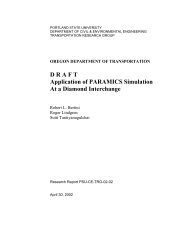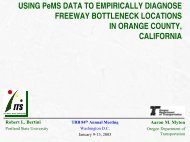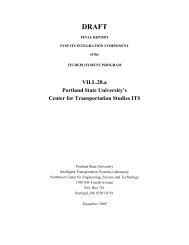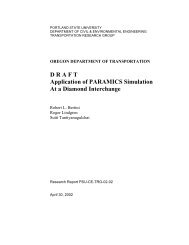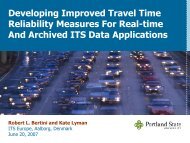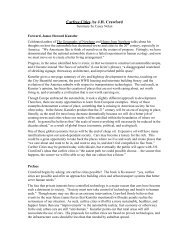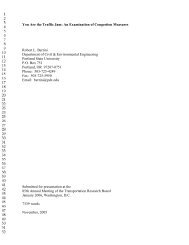Generating Transit Performance Measures with ... - Transportation
Generating Transit Performance Measures with ... - Transportation
Generating Transit Performance Measures with ... - Transportation
You also want an ePaper? Increase the reach of your titles
YUMPU automatically turns print PDFs into web optimized ePapers that Google loves.
Bertini and El-Geneidy Paper No. 03- 4393 117<br />
400<br />
6,000<br />
On Off Dwell<br />
350<br />
5,000<br />
300<br />
Number of Passengers<br />
250<br />
200<br />
150<br />
4,000<br />
3,000<br />
2,000<br />
Total Dwell Time<br />
100<br />
50<br />
1,000<br />
0<br />
0<br />
Downtown<br />
FIGURE 8 Total dwell time and passenger movement during 1 day of outbound trips on Route 14.<br />
stop (7). Note that the layovers at the ends of the route were excluded<br />
from the graphs.<br />
SEGMENT-LEVEL PERFORMANCE MEASURES<br />
Many route-level TPMs can also be applied to key segments of<br />
important routes that may require analytical focus. As one example,<br />
a portion of Route 12 has been analyzed to investigate the population<br />
that is being served in a particular area. Figure 9 shows a route segment<br />
map accompanied by a histogram for the land use around this<br />
particular route segment, along <strong>with</strong> the characterization of passenger<br />
movement at each stop. From this analysis, it is shown that the<br />
highest passenger movement occurred around transfer points <strong>with</strong><br />
the highest proportion of commercial land around them. These transfer<br />
points are locations that deserve additional attention, particularly<br />
if timed transfer policies are desired.<br />
POINT-LEVEL PERFORMANCE MEASURES<br />
From the customer’s standpoint, it is often the point-level performance<br />
that is first perceived. If one takes a system perspective, it is<br />
also clear that small delays at individual stops are difficult to make<br />
up, particularly in congested traffic conditions. For any particular<br />
point on a bus route, it would be possible to report the following (7):<br />
• Number of scheduled trips passing this point,<br />
• Number of actual trips,<br />
• Percentage of actual and scheduled trips,<br />
• Number of passengers carried,<br />
• For a maximum 30-min interval of loading time,<br />
• Time interval,<br />
• Average deviation,<br />
• Standard deviation,<br />
• Number of vehicles passing,<br />
• Number of passengers moving, and<br />
• Number of passengers per vehicle.<br />
To examine on-time performance at a significant stop, one can see<br />
that Figure 10 shows a scheduled cumulative bus arrival function for<br />
the stop at Hawthorne and 39th (which is also a time point). The<br />
x-axis is time, and the y-axis records the vehicle number and its<br />
scheduled arrival time. Also shown is a cumulative arrival function<br />
for actual vehicle arrivals. The value of presenting the data in this<br />
fashion is that it is possible to see the vehicular delay as the difference<br />
between the two step-functions. Another benefit is that it is<br />
possible to see the scheduled and actual headways from the perspective<br />
of passengers at the particular stop. Also shown in the figure<br />
are the total passenger movements associated <strong>with</strong> each vehicle.<br />
From this figure, the effects of bus bunching are extremely clear—<br />
that when there are two buses <strong>with</strong> very short headways, the second<br />
bus serves almost no passengers.<br />
From this type of analysis, it would be possible to determine the<br />
percentage of buses that arrived on time during an entire service day,<br />
as well as to compare overall on-time performance <strong>with</strong> that during<br />
the peak periods. Doing so could lead to better decision-making and<br />
prioritization capabilities for stop-level improvements such as stop<br />
consolidations, relocations, boarding area improvements, queue jump<br />
lanes, and traffic signal priority.



